744. Black-crowned Tchagra Tchagra senegalus (Swartkroontjagra)
Order: Passeriformes. Family: Malaconotidae
Description
The Black-crowned Tchagra is a colourful and unmistakable species, 19–22 cm in length. It has a black crown and eye stripes separated by a broad white supercilium. They have a mean-looking hooked beak, typical of the Bushshrikes and the same furtive habits. Sexes alike.
Adult: Forehead, crown and nape black; supercilium buff, long, broad, extending back to nape. Lores black, extending as stripe through eye to otherwise buffy ear coverts. Mantle, back and inner scapulars tawny brown; outer scapulars dark brown, with broad rufous margins. Rump and upper tail coverts greyish brown. Tail black, broadly tipped white, tips broadest on outer rectrices; central pair of rectrices greyish brown, with fine cross-barring. Graduated, outmost rectrices shortest. Wing coverts bright chestnut brown; marginal coverts at carpal joint white. Flight feathers brown, with narrow chestnut outer margins. Underparts pale grey, whiter on chin, centre of throat, belly and undertail coverts; darker on sides of breast and flanks. Bill black. Eyes dark brown or dark blue-grey. Legs and feet grey.
Juvenile has a horn coloured bill, a mottled crown and a buff-tipped tail. It has a yellow bill.
Similar species: The black crown and greyish underparts distinguish it from the Brown-crowned Tchagra and Southern Tchagra. Female Marsh Tchagra has much shorter supercilium, russet (not tawny brown) back, and shorter black tail, lacking white tip.
Distribution
Occurs across sub-Saharan Africa, absent only from the deserts in and around Somalia, large areas of Namibia, and much of South Africa (excluding KwaZulu-Natal, Limpopo Province, Mpumalanga and parts of the Eastern Cape).
Habitat
From dry savanna to moist broadleaved woodland and suburban gardens. It is locally common throughout its range occupying dry, thorny savanna woodland, miombo (Brachystegia)woodland and suburban gardens.
Diet
Mainly insects, also tadpoles, small snakes and lizards. It mainly eats invertebrates, often foraging on the ground, plucking prey from the leaf litter or grass. It also takes insects from leaves and branches, and occasionally from dung.
Breeding
It is a monogamous solitary nester, with males contesting their territories by holding singing duels; the winner is decided by how well it can extend its neck and how loud it can call. The nest is a shallow cup built of rootlets, fine twigs and tendrils bound together with spider web and typically placed in a horizontal or vertical fork in a tree or bush, 1-2 m above ground. Both sexes help with the construction, which usually takes about 7 days. The female lays 1-4, usually two or three heavily marked white eggs. Both sexes, but mainly the female, incubate for 12–15 days to hatching; the chicks fledge after another 15 days, remaining with their parents for most of the non-breeding season.
Call
Loud warbling whistles: wheeya, heeea, hyoooee, whee-hoo. Listen to Bird Call.
Status
Common resident.
Africa Wild Bird Book
- Flutterby
- Posts: 44029
- Joined: Sat May 19, 2012 12:28 pm
- Country: South Africa
- Location: Gauteng, South Africa
- Contact:
Black-crowned Tchagra Photos
744. Black-crowned Tchagra Tchagra senegalus
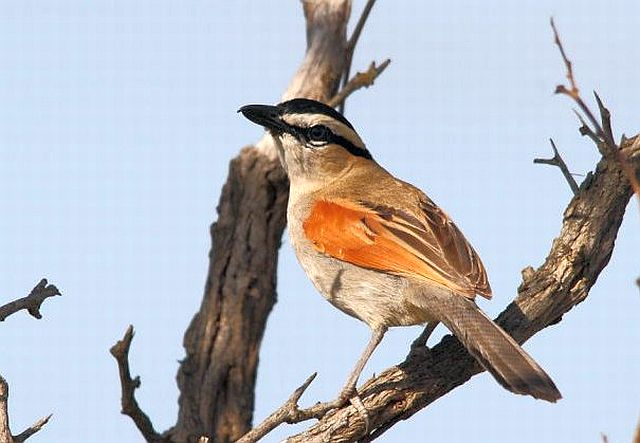
 © nan
© nan
 © Joan
© Joan
Pilanesberg GR
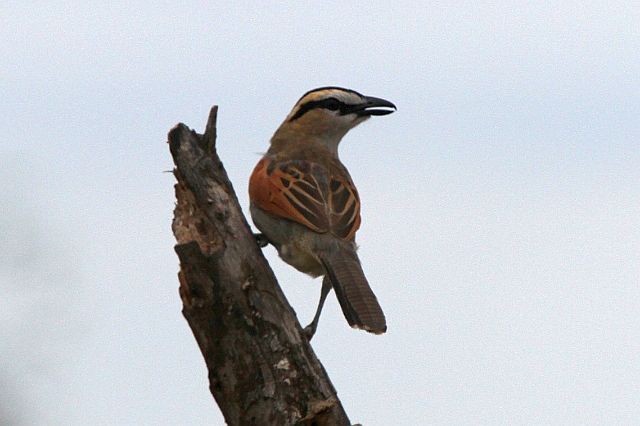 © Tina
© Tina
Kruger National Park, S127
Links:
Species text in The Atlas of Southern African Birds
Sabap2

 © nan
© nan © Joan
© JoanPilanesberg GR
 © Tina
© TinaKruger National Park, S127
Links:
Species text in The Atlas of Southern African Birds
Sabap2
- Flutterby
- Posts: 44029
- Joined: Sat May 19, 2012 12:28 pm
- Country: South Africa
- Location: Gauteng, South Africa
- Contact:
Black-backed Puffback
740. Black-backed Puffback Dryoscopus cubla (Swartrugsneeubal)
Order: Passeriformes. Family: Malaconotidae
Description
17.5 cm. The only shrike in the region to have a large, white rump which is conspicuous (in male) when it is spread and puffed up during display. This bushshrike is black above with a white rump and underparts. It resembles a small boubou but has a shorter tail, white wing coverts and a bright red eye.
Male is glossy black above.
Female is duller and has a white forehead and eyebrow.
Juvenile is initially buff-brown below, later resembles female but has a brown eye and horn-coloured bill.
Distribution
In the eastern, north- and south-eastern parts of South Africa.
Habitat
A wide variety of woodland and forests.
Diet
It mainly eats insects, doing most of its foraging in the upper canopy, gleaning insects from leaves and branches and occasionally catching prey in flight.
Breeding
Monogamous. The nest is a tidy, compact cup made of grass, roots and bark bound together with spider web and lined with fine grass. It is built solely by the female, while the male helps collect material, regurlarly displaying and calling nearby. It is often decorated with lichen and bark, so that it is camouflaged with the forked branch it is bound to. Egg-laying season is almost year-round, but it usually peaks around September-December. It lays 2-3 eggs, which are incubated mainly by the female for about 13 days. The male regurlarly gives her food, occasionaly taking over for short periods so that she can forage for herself. The female is given food by the male, especially insects, which she then feeds to the young nestlings. The chicks stay in the nest for about 18 days and can fend for themselves 3 weeks later, but they can still remain in their parents territory into the next breeding season.
Call
A sharp 2-syllabled chick-weeu, chick-weeu, mostly by the male. Listen to Bird Call.
Status
Common resident, sedentary and found singly or in pairs.
Order: Passeriformes. Family: Malaconotidae
Description
17.5 cm. The only shrike in the region to have a large, white rump which is conspicuous (in male) when it is spread and puffed up during display. This bushshrike is black above with a white rump and underparts. It resembles a small boubou but has a shorter tail, white wing coverts and a bright red eye.
Male is glossy black above.
Female is duller and has a white forehead and eyebrow.
Juvenile is initially buff-brown below, later resembles female but has a brown eye and horn-coloured bill.
Distribution
In the eastern, north- and south-eastern parts of South Africa.
Habitat
A wide variety of woodland and forests.
Diet
It mainly eats insects, doing most of its foraging in the upper canopy, gleaning insects from leaves and branches and occasionally catching prey in flight.
Breeding
Monogamous. The nest is a tidy, compact cup made of grass, roots and bark bound together with spider web and lined with fine grass. It is built solely by the female, while the male helps collect material, regurlarly displaying and calling nearby. It is often decorated with lichen and bark, so that it is camouflaged with the forked branch it is bound to. Egg-laying season is almost year-round, but it usually peaks around September-December. It lays 2-3 eggs, which are incubated mainly by the female for about 13 days. The male regurlarly gives her food, occasionaly taking over for short periods so that she can forage for herself. The female is given food by the male, especially insects, which she then feeds to the young nestlings. The chicks stay in the nest for about 18 days and can fend for themselves 3 weeks later, but they can still remain in their parents territory into the next breeding season.
Call
A sharp 2-syllabled chick-weeu, chick-weeu, mostly by the male. Listen to Bird Call.
Status
Common resident, sedentary and found singly or in pairs.
- Flutterby
- Posts: 44029
- Joined: Sat May 19, 2012 12:28 pm
- Country: South Africa
- Location: Gauteng, South Africa
- Contact:
Black-backed Puffback Photos
740. Black-backed Puffback Dryoscopus cubla
 © Flutterby
© Flutterby
Female
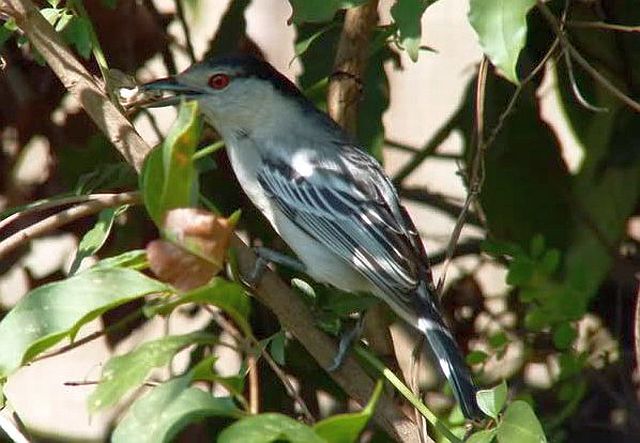 © Bushcraft
© Bushcraft
Female
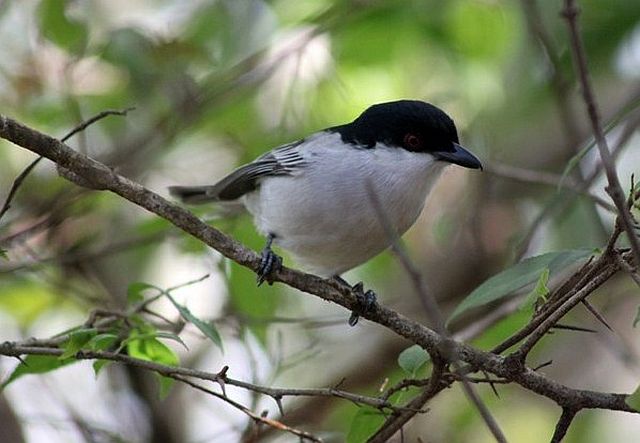 © Heksie
© Heksie
Male
 © nan
© nan
Male
 © lowveldboy
© lowveldboy
Male
Links:
Species text Sabap1
Sabap2
 © Flutterby
© FlutterbyFemale
 © Bushcraft
© BushcraftFemale
 © Heksie
© HeksieMale
 © nan
© nanMale
 © lowveldboy
© lowveldboyMale
Links:
Species text Sabap1
Sabap2
Tropical Boubou
737. Tropical Boubou Laniarius aethiopicus (Tropiese Waterfiskaal)
Order: Passeriformes. Family: Malaconotidae
Description
The Tropical Boubou is fairly large for its family (bushshrikes), 23–25 cm in length. Its weight is between about 38-70 g, but typically adults weigh between 50 and 60 g. Sexes are alike. The adults' upperparts and tail are glossy blue-black except for concealed white spots on the rump, visible only when the wings are spread and the rump feathers are erected. The underparts are white, in some populations with a buffy or pinkish tinge on the breast and flanks, which is not always noticeable except in good light. The wings of most subspecies have a white stripe on the wing coverts, in some extending onto the secondary remiges. The tips of the outer tail feathers can be white in some subspecies. The bill is black, the legs and feet bluish-grey. The irides are dark reddish-brown.
Juveniles are similar but duller. Upperparts mottled by yellowish-ochre to tawny feather tips. Dusky-barred flanks. Bill greyish brown.
Similar species: There are four boubou shrikes in the region and three of them - Southern Boubou, Swamp Boubou (which occurs mostly in the Okavango Delta) and Tropical Boubou (found mostly in Zimbabwe) - are almost identical. Tropical Boubou is separated from Swamp and Southern boubous by creamy white to pinkish underparts and very distinctive call. Easily confused with the Southem Boubou but is generally paler below, showing a more marked contrast between its black upperparts and pinkish white underparts. The pink-tinged underparts distinguish it from the Swamp Boubou. Southern Boubou has rufous flanks and belly, and Swamp Boubou pure white underparts.
Distribution
Occurs from Liberia to East Africa south to southern Africa, where it is locally common in Zimbabwe and northern Mozambique extending into Botswana and northern Limpopo Province. L. a. limpopoensis – W Mozambique to S Zimbabwe and N South Africa. Hybridizes with Southern Boubou in Limpopo valley. The buffiest of all, without pink tones. Long narrow wing stripe like in major. Outer tail feathers never have white tips
Habitat
It often occupies habitats with dense vegetation, such as montane forest, suburban gardens, thick coastal scrub, savanna and miombo (Brachystegia) woodland, but in arid areas it is more common in riverine scrub.
Diet
An adaptable hunter, it eats mainly insects, but also small vertebrates such as chameleons, skinks, frogs, rodents and snails; occasionally fruit. It often catches its prey off leaves and branches then places them in a small tree fork, where it tears them apart with its bill. It also exploits gatherings of insects in roadside drains or gutters, especially after heavy rains.
Breeding
Monogamous. The nest is a scruffy collection of twigs and rootlets, bound loosely together with strands of spider web. It is usually placed in the fork of a thorny branch, concealed by creepers and other vegetation. The female does most of the nest construction, often starting to build multiple nests before deciding on the optimal one to use that breeding season. The next year, the same female salvages material from her previous nests, using them to construct a string of a new ones. Egg-laying season is almost year-round, peaking from about October-November. It lays 1-3 eggs, which are incubated mainly the female for roughly 14-16 days. During the first few days of their lives, the chicks are mainly fed insects; the size of food items delivered to them increases as they get older until eventually they eat bird nestlings and rodents. Although they can fend for themselves a about 7 weeks old, they still remain dependent on their parents for about 3.5 months more.
Parasitised by Black Cuckoo.
Call
Main song a synchronised duet, haw-wheee-haw or wah-heeya-wah; first and third notes usually by male, second by female. Listen to Bird Call.
Status
Common resident; sedentary and usually in pairs but may be in small family groups after breading season.
Order: Passeriformes. Family: Malaconotidae
Description
The Tropical Boubou is fairly large for its family (bushshrikes), 23–25 cm in length. Its weight is between about 38-70 g, but typically adults weigh between 50 and 60 g. Sexes are alike. The adults' upperparts and tail are glossy blue-black except for concealed white spots on the rump, visible only when the wings are spread and the rump feathers are erected. The underparts are white, in some populations with a buffy or pinkish tinge on the breast and flanks, which is not always noticeable except in good light. The wings of most subspecies have a white stripe on the wing coverts, in some extending onto the secondary remiges. The tips of the outer tail feathers can be white in some subspecies. The bill is black, the legs and feet bluish-grey. The irides are dark reddish-brown.
Juveniles are similar but duller. Upperparts mottled by yellowish-ochre to tawny feather tips. Dusky-barred flanks. Bill greyish brown.
Similar species: There are four boubou shrikes in the region and three of them - Southern Boubou, Swamp Boubou (which occurs mostly in the Okavango Delta) and Tropical Boubou (found mostly in Zimbabwe) - are almost identical. Tropical Boubou is separated from Swamp and Southern boubous by creamy white to pinkish underparts and very distinctive call. Easily confused with the Southem Boubou but is generally paler below, showing a more marked contrast between its black upperparts and pinkish white underparts. The pink-tinged underparts distinguish it from the Swamp Boubou. Southern Boubou has rufous flanks and belly, and Swamp Boubou pure white underparts.
Distribution
Occurs from Liberia to East Africa south to southern Africa, where it is locally common in Zimbabwe and northern Mozambique extending into Botswana and northern Limpopo Province. L. a. limpopoensis – W Mozambique to S Zimbabwe and N South Africa. Hybridizes with Southern Boubou in Limpopo valley. The buffiest of all, without pink tones. Long narrow wing stripe like in major. Outer tail feathers never have white tips
Habitat
It often occupies habitats with dense vegetation, such as montane forest, suburban gardens, thick coastal scrub, savanna and miombo (Brachystegia) woodland, but in arid areas it is more common in riverine scrub.
Diet
An adaptable hunter, it eats mainly insects, but also small vertebrates such as chameleons, skinks, frogs, rodents and snails; occasionally fruit. It often catches its prey off leaves and branches then places them in a small tree fork, where it tears them apart with its bill. It also exploits gatherings of insects in roadside drains or gutters, especially after heavy rains.
Breeding
Monogamous. The nest is a scruffy collection of twigs and rootlets, bound loosely together with strands of spider web. It is usually placed in the fork of a thorny branch, concealed by creepers and other vegetation. The female does most of the nest construction, often starting to build multiple nests before deciding on the optimal one to use that breeding season. The next year, the same female salvages material from her previous nests, using them to construct a string of a new ones. Egg-laying season is almost year-round, peaking from about October-November. It lays 1-3 eggs, which are incubated mainly the female for roughly 14-16 days. During the first few days of their lives, the chicks are mainly fed insects; the size of food items delivered to them increases as they get older until eventually they eat bird nestlings and rodents. Although they can fend for themselves a about 7 weeks old, they still remain dependent on their parents for about 3.5 months more.
Parasitised by Black Cuckoo.
Call
Main song a synchronised duet, haw-wheee-haw or wah-heeya-wah; first and third notes usually by male, second by female. Listen to Bird Call.
Status
Common resident; sedentary and usually in pairs but may be in small family groups after breading season.
Tropical Boubou Photos
737. Tropical Boubou Laniarius aethiopicus (Tropiese waterfiskaal)
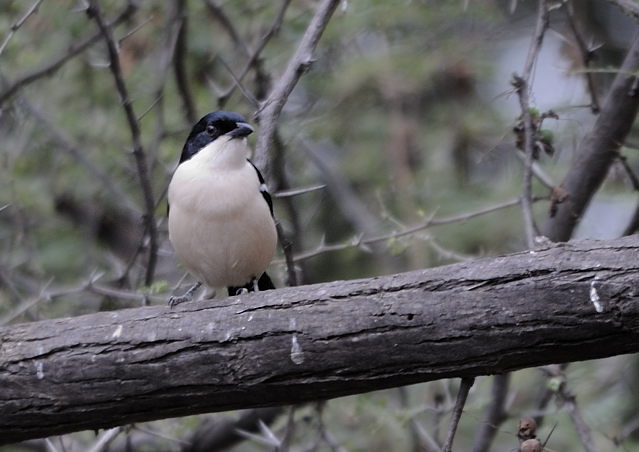 © Dewi
© Dewi
Links:
Species text in The Atlas of Southern African Birds
Sabap2
Wikipedia
 © Dewi
© DewiLinks:
Species text in The Atlas of Southern African Birds
Sabap2
Wikipedia
Swamp Boubou
738. Swamp Boubou Laniarius bicolor
Order: Passeriformes. Family: Malaconotidae
Description
25cm; 53g
Sexes alike. Distinguised from Tropical Boubou by almost snow-white underparts (lacking pinkish wash) and distinctive call. Upperparts are a glossy bluish black. Juvenile upperparts are spotted buff, lightly barred below.
Distribution
Occurs from Cameroon and the DRC to southern Africa, where it is locally common in northern Botswana, the Caprivi Strip and the upper-most reaches of Namibia.
Habitat
Along watercourses with surrounding dense vegetetation, such as tall reedbeds, Papyrus and Water figs.
Diet
It eats a variety of insects, fruit and rarely frogs, doing most of its foraging in reedbeds or trees, gleaning prey from the vegetation. It also forages on the ground, flicking plant detritus around with its bill in a manner similar to thrushes.
Breeding
The nest is a shallow cup of woven twigs and rootlets, usually placed in small thicket or bush about 2-3 metres above ground. Egg-laying season is almost year round, usually peaking around November. It lays about 2 eggs which are incubated by both sexes, singing a duet whenever they change shifts.
Call
Usually given in duet. Male gives mellow whhawww whistle, followed almost immediately by rattling cackle of the female, kikikakakrrrr, so that the 2 sound almost simultaneous.
Status
Locally common resident; sedentary and generally shy and skulking. Not threatened.
Order: Passeriformes. Family: Malaconotidae
Description
25cm; 53g
Sexes alike. Distinguised from Tropical Boubou by almost snow-white underparts (lacking pinkish wash) and distinctive call. Upperparts are a glossy bluish black. Juvenile upperparts are spotted buff, lightly barred below.
Distribution
Occurs from Cameroon and the DRC to southern Africa, where it is locally common in northern Botswana, the Caprivi Strip and the upper-most reaches of Namibia.
Habitat
Along watercourses with surrounding dense vegetetation, such as tall reedbeds, Papyrus and Water figs.
Diet
It eats a variety of insects, fruit and rarely frogs, doing most of its foraging in reedbeds or trees, gleaning prey from the vegetation. It also forages on the ground, flicking plant detritus around with its bill in a manner similar to thrushes.
Breeding
The nest is a shallow cup of woven twigs and rootlets, usually placed in small thicket or bush about 2-3 metres above ground. Egg-laying season is almost year round, usually peaking around November. It lays about 2 eggs which are incubated by both sexes, singing a duet whenever they change shifts.
Call
Usually given in duet. Male gives mellow whhawww whistle, followed almost immediately by rattling cackle of the female, kikikakakrrrr, so that the 2 sound almost simultaneous.
Status
Locally common resident; sedentary and generally shy and skulking. Not threatened.
- Flutterby
- Posts: 44029
- Joined: Sat May 19, 2012 12:28 pm
- Country: South Africa
- Location: Gauteng, South Africa
- Contact:
Swamp Boubou Photos
738. Swamp Boubou Laniarius bicolor
 © Dewi
© Dewi
Caprivi Strip, Caprivi River Lodge, Zambezi River.
 © Dindingwe
© Dindingwe
Caprivi Strip, Namibia
Links:
http://www.biodiversityexplorer.org/bir ... icolor.htm
Roberts Bird Guide
 © Dewi
© DewiCaprivi Strip, Caprivi River Lodge, Zambezi River.
 © Dindingwe
© DindingweCaprivi Strip, Namibia
Links:
http://www.biodiversityexplorer.org/bir ... icolor.htm
Roberts Bird Guide
- Flutterby
- Posts: 44029
- Joined: Sat May 19, 2012 12:28 pm
- Country: South Africa
- Location: Gauteng, South Africa
- Contact:
Southern Boubou
736. Southern Boubou Laniarius ferrugineus (Suidelike Waterfiskaal)
Order: Passeriformes. Family: Malaconotidae
Description
Black upperparts. Cinnamon colouring of belly sometimes extends in pale wash to throat, but is always richer towards belly and vent. White bar across shoulders and wings.
Female is slightly greyer above, with a rufous wash on the breast.
Juvenile is mottled buff-brown above and barred below.
Similar to Southern Fiscal but has a shorter tail and the white on the wing extends onto the secondaries. It may be distinguished from Tropical Boubou and Swamp Boubou by its rufous flanks, undertail and belly. Tropical Boubou has pink underparts; underparts of Swamp Boubou white.
Distribution
Endemic to southern Africa, occurring from south-eastern Botswana through Limpopo and North-West Provinces to southern Mozambique, extending down the coast to KwaZulu-Natal, Eastern and Western Capes.

Habitat
Thickets in riverine and evergreen forests.
Diet
Usually keeps to thick vegetation, where it forages mainly for invertebrates, eggs and nestlings, but also fruit and seeds.
Breeding
The nest is built solely by the female and is an untidy, loosely woven bowl made of twigs, roots and grasses, sometimes bound with spider web. It is usually placed in a fork of a tree or bush, concealed by foliage. If the nest is repeatedly disturbed, the breeding pair rip it apart and, using the same materials, rebuild it nearby. Egg-laying season is from about August-March, peaking around September-December. It lays 2-3 eggs, which are incubated by both sexes for about 16-17 days. The chicks leave the nest at about 16-17 days old, becoming semi-independent after about 8 weeks, after which they remain with their parents for roughly 3 weeks more.
Call
The call is often heard as members of a pair keep contact by duetting a ko-ko replied to with kweet or boo-boo followed by whee-oo and wide variety of other sounds. Listen to Bird Call
Status
Common endemic resident.
Order: Passeriformes. Family: Malaconotidae
Description
Black upperparts. Cinnamon colouring of belly sometimes extends in pale wash to throat, but is always richer towards belly and vent. White bar across shoulders and wings.
Female is slightly greyer above, with a rufous wash on the breast.
Juvenile is mottled buff-brown above and barred below.
Similar to Southern Fiscal but has a shorter tail and the white on the wing extends onto the secondaries. It may be distinguished from Tropical Boubou and Swamp Boubou by its rufous flanks, undertail and belly. Tropical Boubou has pink underparts; underparts of Swamp Boubou white.
Distribution
Endemic to southern Africa, occurring from south-eastern Botswana through Limpopo and North-West Provinces to southern Mozambique, extending down the coast to KwaZulu-Natal, Eastern and Western Capes.

Habitat
Thickets in riverine and evergreen forests.
Diet
Usually keeps to thick vegetation, where it forages mainly for invertebrates, eggs and nestlings, but also fruit and seeds.
Breeding
The nest is built solely by the female and is an untidy, loosely woven bowl made of twigs, roots and grasses, sometimes bound with spider web. It is usually placed in a fork of a tree or bush, concealed by foliage. If the nest is repeatedly disturbed, the breeding pair rip it apart and, using the same materials, rebuild it nearby. Egg-laying season is from about August-March, peaking around September-December. It lays 2-3 eggs, which are incubated by both sexes for about 16-17 days. The chicks leave the nest at about 16-17 days old, becoming semi-independent after about 8 weeks, after which they remain with their parents for roughly 3 weeks more.
Call
The call is often heard as members of a pair keep contact by duetting a ko-ko replied to with kweet or boo-boo followed by whee-oo and wide variety of other sounds. Listen to Bird Call
Status
Common endemic resident.
- Flutterby
- Posts: 44029
- Joined: Sat May 19, 2012 12:28 pm
- Country: South Africa
- Location: Gauteng, South Africa
- Contact:
Southern Boubou Photos
736. Southern Boubou Laniarius ferrugineus
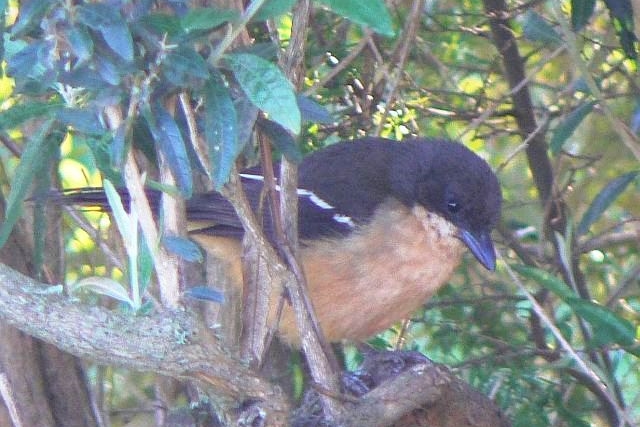 © Toko
© Toko
Addo Elephant National Park
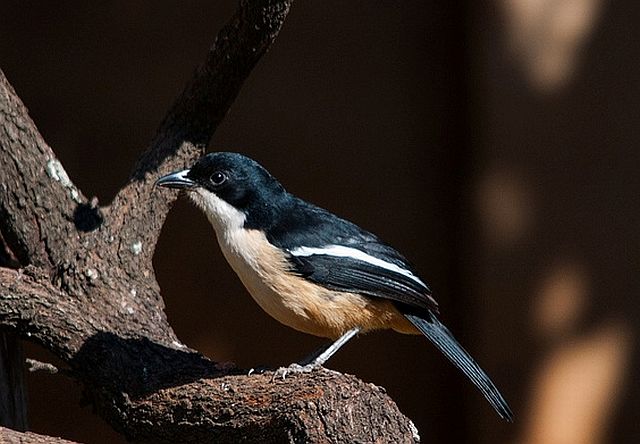 © steamtrainfan
© steamtrainfan
 © Pumbaa
© Pumbaa
Kruger National Park
 © ExFmem
© ExFmem
Kruger National Park, Tamboti
De Mond Nature Reserve © graham
Links:
Sabap2
Tony Harris. Shrikes and Bush-shrikes
 © Toko
© TokoAddo Elephant National Park
 © steamtrainfan
© steamtrainfan © Pumbaa
© PumbaaKruger National Park
 © ExFmem
© ExFmemKruger National Park, Tamboti
De Mond Nature Reserve © graham
Links:
Sabap2
Tony Harris. Shrikes and Bush-shrikes


